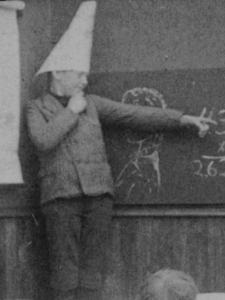Don’t buy NEA snake oil
 Editor’s note: This is cross-posted from our friend Larry Sand. The NEA is the parent union of the powerful California Teachers Association.
Editor’s note: This is cross-posted from our friend Larry Sand. The NEA is the parent union of the powerful California Teachers Association.
July 24, 2012
By Larry Sand
The teachers union uses bogus numbers to con the public into believing that education needs more funding.
The National Education Association is relentless in its quest to raise taxes. In its latest gambit — “Massive Budget Cuts Threaten America’s Children” — the union claims that “…America’s schools have added 5.4 million students since 2003.” The only documentation for this outlandish number – an 11.1 percent increase – is a link to another article where they state the same fiction.
However, the National Council for Educational Statistics, an organization without an agenda, tells a far different story. NCES says that in 2003-2004 there were 48,540,375 K-12 students enrolled in the nation’s pubic schools. In 2010-2011, that number climbed to 49,484,181, an increase of just under 944,000 students – a 1.9 percent gain.
NEA also tries to convince us that severe spending cuts are dooming our children to an inferior education. But Mike Antonucci offers a realistic look at spending data culled from the U.S. Census Bureau. He came up with a chart which shows that between 2004-2005 and 2009-2010 per student spending increased 22 percent nationwide (9.3 percent after correcting for inflation.)
However, as Antonucci points out, the spending flattened out toward the end of that five year period. And in all likelihood we will be in for a decrease in the near term. But, what must be determined is how spending correlates to student achievement.
Compared to other countries around the world, we are fourth in spending after Luxembourg, Switzerland and Norway. Yet,
“The three-yearly OECD Programme for International Student Assessment (PISA) report, which compares the knowledge and skills of 15-year-olds in 70 countries around the world, ranked the United States 14th out of 34 OECD countries for reading skills, 17th for science and a below-average 25th for mathematics.”
Not much of a correlation there. What about individual states? A recent study about the U.S. failure to close the international achievement gap released by Education Next finds nothing at all convincing.
“No significant correlation was found between increased spending on education and test score gains. For example, Maryland, Massachusetts, and New Jersey posted large gains in student performance after boosting spending, but New York, Wyoming, and West Virginia had only marginal test-score gains to show from increased expenditures.”
Class size
The spendthrift teachers unions and their fellow travelers insist that we need more teachers because small class size is an essential component to a good education, but there is no evidence to back up this assertion. In fact, in a wonderfully contrarian op-ed, Cato Institute’s Andrew Coulson makes his case that “America Has Too Many Teachers” and other school employees.
“Since 1970, the public school workforce has roughly doubled—to 6.4 million from 3.3 million—and two-thirds of those new hires are teachers or teachers’ aides. Over the same period, enrollment rose by a tepid 8.5%. Employment has thus grown 11 times faster than enrollment. If we returned to the student-to-staff ratio of 1970, American taxpayers would save about $210 billion annually in personnel costs.”
Referring to the NAEP tests, also known as the nation’s report card, Coulson says that in spite of the increased workforce,
“These tests, first administered four decades ago, show stagnation in reading and math and a decline in science. Scores for black and Hispanic students have improved somewhat, but the scores of white students (still the majority) are flat overall, and large demographic gaps persist. Graduation rates have also stagnated or fallen. So a doubling in staff size and more than a doubling in cost have done little to improve academic outcomes.”
Ah, but what about the kids who do get lost in larger classes? A story in the Huffington Post addresses this, focusing on a sweet eight year old girl in New York City who is having a tough time in school because, due to budget cuts, her 3rd grade class now has 32 students. To be sure some students are hurt by being in bigger classes. But despite the appeal to sentiment, it is hardly a universal truth.
Teacher-pupil ratio
Hoover Institution senior fellow and economist Eric Hanushek has devoted much of his time studying this issue. In 1998, he released the results of his impressive research.
“Examining 277 separate studies on the effect of teacher-pupil ratios and class-size averages on student achievement, he found that 15 percent of the studies found an improvement in achievement, while 72 percent found no effect at all—and 13 percent found that reducing class size had a negative effect on achievement. While Hanushek admits that in some cases, children might benefit from a small-class environment, there is no way ‘to describe a priori situations where reduced class size will be beneficial.’”
In our fiscally tough times it is more important than ever not to be swayed by emotion, demagoguery, and plain ol’ BS. Americans must do their due diligence and not be conned by the hucksters. And be especially wary of the teachers unions; the snake oil they sell is particularly venomous.
About the author: Larry Sand, a former classroom teacher, is the president of the non-profit California Teachers Empowerment Network — a non-partisan, non-political group dedicated to providing teachers with reliable and balanced information about professional affiliations and positions on educational issues.
Related Articles
San Diego school board backs embattled president
Last week, at least one member of the San Diego school board — Vice President John Lee Evans — appeared
Vergara ruling: Silicon Valley titan KOs teachers unions
In 16 pages, Los Angeles Superior Court Judge Rolf M. Treu dealt California’s teachers unions an unprecedented defeat. Using unsparing, uncompromising
Supreme Court has good news for CTA, CFT
A recent U.S. Supreme Court hearing on allegations of racial discrimination in Texas public housing programs may have major implications




